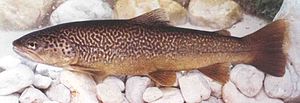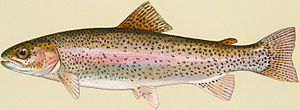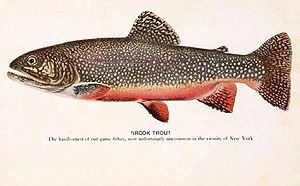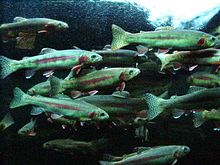
Trout
About this schools Wikipedia selection
SOS Children, which runs nearly 200 sos schools in the developing world, organised this selection. Child sponsorship helps children one by one http://www.sponsor-a-child.org.uk/.
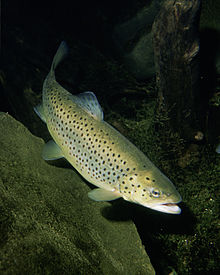
Trout is the name for a number of species of freshwater fish belonging to the genera Oncorhynchus, Salmo and Salvelinus, all of the subfamily Salmoninae of the family Salmonidae. The word trout is also used as part of the name of some non-salmonid fish such as Cynoscion nebulosus, the spotted seatrout or speckled trout.
Trout are closely related to salmon and char (or charr): species termed salmon and char occur in the same genera as do trout (Oncorhynchus - Pacific salmon and trout, Salmo - Atlantic salmon and various trout, Salvelinus - char and trout).
Most trout such as Lake trout live in freshwater lakes and/or rivers exclusively, while there are others such as the Rainbow trout which may either live out their lives in fresh water, or spend two or three years at sea before returning to fresh water to spawn, a habit more typical of salmon. A rainbow trout that spends time in the ocean is called a steelhead.
Trout are an important food source for humans and wildlife including brown bears, birds of prey such as eagles, and other animals. They are classified as oily fish.
Species
The name trout is commonly used for some species in three of the seven genera in the subfamily Salmoninae: Salmo, Atlantic species; Oncorhynchus, Pacific species; and Salvelinus, which includes fish also sometimes called char or charr. Fish referred to as trout include:
- Genus Salmo
-
- Adriatic trout, Salmo obtusirostris
- S. o. oxyrhynchus
- S. o. salonitana
- S. o. krkensis
- S. o. zetensis
- S. o. rynolanis
- S. o. cordonia
- S. o. alexiumsis
- Salmo trutta
- Brown trout, S. t. morpha fario and S. t. morpha lacustris
- Sea trout, S. t. morpha trutta
- Flathead trout, Salmo platycephalus
- Marble trout, Soca River trout or Soča trout – Salmo marmoratus
- Ohrid trout, Salmo letnica, S. balcanicus (exctinct), S. lumi, and S. aphelios
- Sevan trout, Salmo ischchan
- Winter bakhtak, S. i. ischchan
- Summer bakhtak, S. i. aestivalis
- Gegharkuni, S. i. gegarkuni
- Bojak, S. i. danilewskii
- Adriatic trout, Salmo obtusirostris
- Genus Oncorhynchus
-
- Biwa trout, Oncorhynchus masou rhodurus
- Cutthroat trout, Oncorhynchus clarki
- Coastal cutthroat trout, O. c. clarki
- Crescenti trout, O. c. crescenti
- Alvord cutthroat trout O. c. alvordensis (extinct)
- Bonneville cutthroat trout O. c. utah
- Humboldt cutthroat trout O. c. spp.
- Lahontan cutthroat trout O. c. henshawi
- Whitehorse Basin cutthroat trout, O. c. spp.
- Paiute cutthroat trout O. c. seleniris
- Snake River fine-spotted cutthroat trout, O. c. behnkei
- Westslope cutthroat trout O. c. lewisi
- Yellowfin cutthroat trout O. c. macdonaldi (extinct)
- Yellowstone cutthroat trout O. c. bouvieri
- Colorado River cutthroat trout O. c. pleuriticus
- Greenback cutthroat trout O. c. stomias
- Rio Grande cutthroat trout O. c. virginalis
- Coastal cutthroat trout, O. c. clarki
- Oncorhynchus gilae
- Gila trout, O. g. gilae
- Apache trout, O. g. apache
- Rainbow trout, Oncorhynchus mykiss
- Kamchatkan rainbow trout, Oncorhynchus mykiss mykiss
- Columbia River redband trout, Oncorhynchus mykiss gairdnerii
- Coastal rainbow trout/Steelhead trout, Oncorhynchus mykiss irideus
- Beardslee trout, Oncorhynchus mykiss irideus var. beardsleei
- Great Basin redband trout, Oncorhynchus mykiss newberrii
- Golden trout, Oncorhynchus mykiss aguabonita
- Kern River rainbow trout, Oncorhynchus mykiss aguabonita var. gilberti
- Sacramento golden trout, Oncorhynchus mykiss aguabonita var. stonei
- Little Kern golden trout, Oncorhynchus mykiss aguabonita var. whitei
- Kamloops rainbow trout, Oncorhynchus mykiss kamloops
- Baja California rainbow trout, Nelson's trout, or San Pedro Martir trout, Oncorhynchus mykiss nelsoni
- Eagle Lake trout, Oncorhynchus mykiss aquilarum
- McCloud River redband, Oncorhynchus mykiss stonei
- Sheepheaven Creek redband, Oncorhynchus mykiss spp.
- Mexican Golden Trout, Oncorhynchus chrysogaster (Includes as many as eight other species or sub-species, not yet formally named)
- Genus Salvelinus (Char)
-
- Brook trout, Salvelinus fontinalis
- Aurora trout, S. f. timagamiensis
- Bull trout, Salvelinus confluentus
- Salvelinus malma
- Dolly Varden trout, S. m. malma
- Southern Dolly Varden, S. m. krascheninnikova
- S. m. miyabei
- Lake trout, Salvelinus namaycush
- Silver trout, † Salvelinus agassizi (extinct)
- Brook trout, Salvelinus fontinalis
- Hybrids
- Tiger trout, Salmo trutta X Salvelinus fontinalis
- Splake, Salvelinus namaycush X Salvelinus fontinalis
Anatomy
Trout that live in different environments can have dramatically different colorations and patterns. Mostly, these colors and patterns form as camouflage, based on the surroundings, and will change as the fish moves to different habitats. Trout in, or newly returned from the sea, can look very silvery, while the same fish living in a small stream or in an alpine lake could have pronounced markings and more vivid coloration; it is also possible that in some species this signifies that they are ready to mate. It is virtually impossible to define a particular colour pattern as belonging to a specific breed; however, in general, wild fish are claimed to have more vivid colors and patterns.
Trout have fins entirely without spines, and all of them have a small adipose fin along the back, near the tail. The pelvic fins sit well back on the body, on each side of the anus. The swim bladder is connected to the esophagus, allowing for gulping or rapid expulsion of air, a condition known as physostome. Unlike many other physostome fish, the trout do not use their bladder as an auxiliary device for oxygen uptake, relying solely on their gills.
There are many species, and even more populations that are isolated from each other and morphologically different. However, since many of these distinct populations show no significant genetic differences, what may appear to be a large number of species is considered a much smaller number of distinct species by most ichthyologists. The trout found in the eastern United States are a good example of this. The brook trout, the aurora trout, and the (extinct) silver trout all have physical characteristics and colorations that distinguish them, yet genetic analysis shows that they are one species, Salvelinus fontinalis.
Lake trout (Salvelinus namaycush), like brook trout, belong to the char genus. Lake trout inhabit many of the larger lakes in North America, and live much longer than rainbow trout, which have an average maximum lifespan of 7 years. Lake trout can live many decades, and can grow to more than 30 kilograms (66 lb).
Habitat
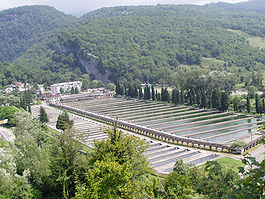
Trout are usually found in cool (50–60 °F, 10–16 °C), clear streams and lakes, although many of the species have anadromous strains as well. Young trout are referred to as troutlet, troutling or fry. They are distributed naturally throughout North America, northern Asia and Europe. Several species of trout were introduced to Australia and New Zealand by amateur fishing enthusiasts in the 19th century, effectively displacing and endangering several upland native fish species. The introduced species included brown trout from England and rainbow trout from California. The rainbow trout were a steelhead strain, generally accepted as coming from Sonoma Creek. The rainbow trout of New Zealand still show the steelhead tendency to run up rivers in winter to spawn. The closest resemblance of seema trout and other trout family can be found in the Himalayan Region of India, Nepal, Bhutan, Pakistan and in Tian Shan mountains of Kyrgyzstan.
Diet
Trout generally feed on other fish, and soft bodied aquatic invertebrates, such as flies, mayflies, caddisflies, stoneflies, mollusks and dragonflies. In lakes, various species of zooplankton often form a large part of the diet. In general, trout longer than about 300 millimetres (12 in) prey almost exclusively on fish, where they are available. Adult trout will devour smaller fish up to 1/3 their length. Trout may feed on shrimp, mealworms, bloodworms, insects, small animal parts, and eel.
1 fillet of trout (79g) contains:
- Calories :117
- Fat (g): 5.22
- Carbohydrates (g): 0
- Fibers (g): 0
- Protein (g): 16.41
- Cholesterol (mg): 46
As food
As a group, trout are somewhat bony, but the flesh is generally considered to be tasty. The flavor of the flesh is heavily influenced by the diet of the fish. For example, trout that have been feeding on crustaceans tend to be more flavorful than those feeding primarily on insect life. Additionally, they provide a good fight when caught with a hook and line, and are sought after recreationally. Because of their popularity, trout are often raised on fish farms and planted into heavily fished waters, in an effort to mask the effects of overfishing. While they can be caught with a normal rod and reel, fly fishing is a distinctive method developed primarily for trout, and now extended to other species. Farmed trout and char are also sold commercially as food fish.
According to the British Nutrition Foundation, trout contain one of the lowest amounts of dioxins (a type of environmental contaminant) of all oily fishes.
River fishing
Understanding how moving water shapes the stream channel makes it easier to find trout. In most streams, the current creates a riffle-run-pool pattern that repeats itself over and over. A deep pool may hold a big brown trout, but rainbows and smaller browns are likely found in runs. Riffles are where you will find small trout, called troutlet, during the day and larger trout crowding in during morning and evening feeding periods.
- Riffles have a fast current and shallow water. This gives way to a bottom of gravel, rubble or boulder. Riffles are morning and evening feeding areas. Trout usually spawn just above or below riffles, but may spawn right in them.
- Runs are deeper than riffles with a moderate current and are found between riffles and pools. The bottom is made up of small gravel or rubble. These hot spots hold trout almost anytime, if there is sufficient cover.
- Pools are smoother and look darker than the other areas of the stream. The deep, slow-moving water generally has a bottom of silt, sand, or small gravel. Pools make good midday resting spots for medium to large trout.
- It is recommended that when fishing for trout, that the fisher(s) should use line in the 4–8 lb test for streamfish, and stronger line with the same diameter for trout from the sea or from a large lake, such as Lake Michigan. It is also recommended to use a hook size 8-5 for trout of all kind. Trout, especially farm-raised ones, tend to like salmon eggs, worms, minnows, cut bait, corn, or marshmallows.
